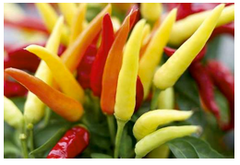15 Arthritis Fighting Foods
Science has shown that there is a link between the foods we eat and the severity of arthritis symptoms. This list of foods will assist your body in fighting the affects of arthritis and its symptoms of joint pain and inflammation.
Salmon
Salmon is rich in Omega 3 fatty acids and many studies have shown that an omega 3 rich diet can help decrease the inflammation of joints. Whether you enjoy salmon in Sushi or maybe in a Salad, this food is great as a main protein in your meal.
Chilli
Chilli peppers contain a component called capsicum. Capsicum is believed to reduce pair and inflammation. Chillies are great for currys and tasty in pestos, perfect for salads on hot summer days or even added to stir-frys or that Italian styled pasta dish.
Blueberries
Blueberries are rich in bioflavonoids which are believed to act as antioxidants and have anti-inflammatory properties. This fruit is delicious on its own or can be enjoyed in desserts and muffins or even in fruit smoothies.
Broccoli
Broccoli is a vegetable that is rich in Vitamin C which helps to build collagen in cartilage. This helps to cushion joints. Broccoli can be enjoyed raw in salads, stir-frys and is delicious roasted. Fussy eaters can always add to a fruit smoothie if they don't enjoy the taste.
Spinach
Spinach is rich in the nutrient Carotenoid which helps to reduce swelling in certain types of srthrilis such as Rheumatoid arthritis. Spinach can be enjoyed Raw or steamed. It can be added to salads or used in side dishes such as creamed spinach. It can be very tasty in pasta dishes or quiches.
Sweet Potatoes
Another vegetable rich in carotenoids and vitamin D, known to build healthy bones. These vegetables are inexpensive and really tasty. Enjoy them roasted or grilled with a little olive oil and seasoning. Sweet potatoes can also be enjoyed in stews or soups.
Ginger
Ginger adds a special zest and flavor to dishes and contains a potent anti-inflammatory called gingerols. Many studies have shown that ginger has helped many people with pain reduction and improvement in joint movement. Ginger can be enjoyed in Asian dishes and many vegetable dishes too.
Yoghurt
The bacteria in yoghurt has been studied and documented as being beneficial in fighting inflammation pain such as in the hand joints. The bacteria also aid our body to absorb nutrients such as calcium. Add fruit to plain yoghurt or mix into a fruit smoothie. Also delicious with muesli in the mornings as a great start to your day.
Brazil nuts
Brazil nuts contain Selenium, a joint-healing antioxidant. The antioxidant affects of selenium have been shown to absorb molecules which destroy joints. This is believed to assist in lowered joint inflammation.
Brown Rice
This ancient food is rich in Selenium and so aids in decreasing rheumatoid arthritis pain and inflammation. Brown rice is healthier than white rice as it is less processed thereby eliminating the loss of many essential nutrients. Rice can be used as a tasty side dish to curries and stir-frys.
Avocados
This tasty fruit is a super food rich in monounsaturated oils and essential fatty acids which can promote the repair of cartilage in osteoarthritis. Avocados are great in salads and on sandwiches. They also make a great guacamole dish for wraps.
Apples
Apples have always been known to be a great source of goodness for our bodies. Apples contain anti-inflammatory antioxidants which are beneficial to arthritis sufferers. The antioxidants are more concentrated in the skin of the apple. Apples are enjoyed as a lunchbox favourite but can be steamed and used in tarts or as an addition to stuffings, muffins or desserts.
Grapes
Grapes contain quercetin, an antioxidant which works with vitamin C to stimulate our immune system to fight inflammation and offers joint and muscle pain relief. Grapes can be enjoyed in fruit salads or in fruit juices.
Soy
Isoflavones are compounds found in Soy products and are believed to lower inflammation levels and also reduce the negative affects of inflammation on the bone. Soy can be found in products such as soy milk and tofu.
Beetroot
This bright red vegetable has brilliant antioxidant properties and has been shown to reduce inflammation. Rich in Vitamin C and fibre this vegetable can be roasted, boiled or pickled and is the perfect compliment to cold meat dishes and crunchy salads.
A healthy, balanced lifestyle is beneficial for many health issues.
|